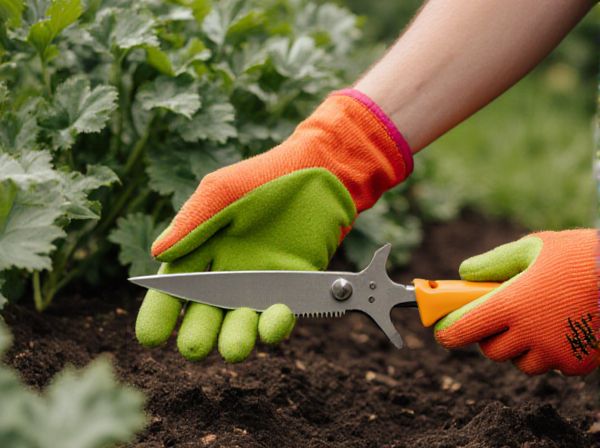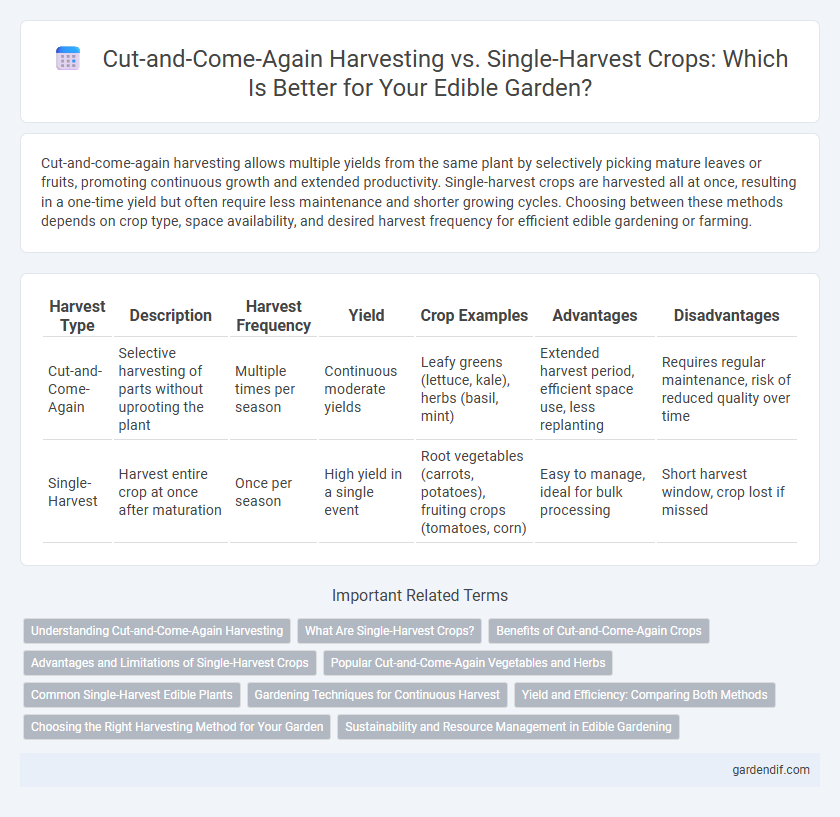
Cut-and-come-again harvesting vs Single-harvest crops Illustration
Cut-and-come-again harvesting allows multiple yields from the same plant by selectively picking mature leaves or fruits, promoting continuous growth and extended productivity. Single-harvest crops are harvested all at once, resulting in a one-time yield but often require less maintenance and shorter growing cycles. Choosing between these methods depends on crop type, space availability, and desired harvest frequency for efficient edible gardening or farming.
Table of Comparison
| Harvest Type | Description | Harvest Frequency | Yield | Crop Examples | Advantages | Disadvantages |
|---|---|---|---|---|---|---|
| Cut-and-Come-Again | Selective harvesting of parts without uprooting the plant | Multiple times per season | Continuous moderate yields | Leafy greens (lettuce, kale), herbs (basil, mint) | Extended harvest period, efficient space use, less replanting | Requires regular maintenance, risk of reduced quality over time |
| Single-Harvest | Harvest entire crop at once after maturation | Once per season | High yield in a single event | Root vegetables (carrots, potatoes), fruiting crops (tomatoes, corn) | Easy to manage, ideal for bulk processing | Short harvest window, crop lost if missed |
Understanding Cut-and-Come-Again Harvesting
Cut-and-come-again harvesting involves selectively picking mature leaves or fruits, allowing the plant to continue growing and produce multiple yields over time, enhancing sustainability and productivity. This method contrasts with single-harvest crops, which require the entire plant to be harvested at once, often leading to a one-time yield and replanting needs. Understanding cut-and-come-again harvesting enables growers to optimize edible crop production, extend harvesting seasons, and reduce waste.
What Are Single-Harvest Crops?
Single-harvest crops are plants that produce a single yield per growing season, requiring the entire crop to be harvested at once. These crops include staple foods like wheat, corn, and root vegetables, which must be fully mature before harvesting to ensure maximum quality and storability. Unlike cut-and-come-again harvesting, single-harvest crops do not regenerate new growth after harvesting, making timing and careful planning essential for optimal yield.
Benefits of Cut-and-Come-Again Crops
Cut-and-come-again crops provide continuous yields by allowing multiple harvests from the same plants, which maximizes garden productivity and reduces the need for replanting. This harvesting method enhances sustainability by decreasing soil disturbance and conserving resources such as water and nutrients. Gardeners benefit from fresher produce over extended periods, improved crop resilience, and reduced labor compared to single-harvest crops.
Advantages and Limitations of Single-Harvest Crops
Single-harvest crops offer the advantage of a concentrated yield, allowing for efficient large-scale harvesting and streamlined processing, which reduces labor costs and maximizes production cycles. However, these crops present limitations such as a single point of harvest that can increase vulnerability to pests, diseases, or adverse weather, potentially resulting in total crop loss. The lack of continuous harvest opportunities also means less flexibility for market timing and consumer demand adjustments compared to cut-and-come-again crops.
Popular Cut-and-Come-Again Vegetables and Herbs
Cut-and-come-again harvesting involves regularly trimming vegetables and herbs like lettuce, spinach, kale, basil, and cilantro, allowing continuous regrowth and multiple harvests throughout the growing season. This method contrasts with single-harvest crops such as carrots or tomatoes, which are harvested once at full maturity and then replaced. Cut-and-come-again vegetables and herbs maximize yield and freshness, making them popular choices for sustainable and efficient home gardens and commercial production.
Common Single-Harvest Edible Plants
Common single-harvest edible plants include root vegetables like carrots, potatoes, and beets, as well as fruits such as tomatoes, pumpkins, and corn, which are harvested once at full maturity. These crops are planted, cultivated, and allowed to grow until they reach peak ripeness, after which the entire plant or fruit is collected and consumed. Unlike cut-and-come-again harvesting, single-harvest crops require replanting each season, making them ideal for bulk yields and seasonal farming cycles.
Gardening Techniques for Continuous Harvest
Cut-and-come-again harvesting techniques maximize yield by allowing continuous picking of leaves, herbs, and greens without damaging the plant, promoting sustained growth throughout the season. Single-harvest crops like root vegetables and grains require a one-time full harvest, often resulting in no further production from the same plant. Employing cut-and-come-again methods enhances garden productivity, reduces waste, and supports a consistent supply of fresh produce ideal for home gardening and small-scale farms.
Yield and Efficiency: Comparing Both Methods
Cut-and-come-again harvesting enhances yield by allowing multiple harvests from the same plant, increasing overall efficiency and reducing the need for frequent replanting. Single-harvest crops, while potentially producing a larger initial yield, require complete replanting after harvest, which can lower long-term productivity. This method comparison highlights cut-and-come-again as more sustainable for continuous yield and resource management in edible crop production.
Choosing the Right Harvesting Method for Your Garden
Cut-and-come-again harvesting maximizes continuous yield by allowing leafy greens like lettuce and spinach to regrow after partial picking, making it ideal for small gardens and fresh produce availability. Single-harvest crops such as root vegetables and corn require full maturity before harvest, offering a one-time yield that suits large-scale or seasonal harvesting strategies. Selecting the appropriate method depends on crop type, garden space, and desired harvest frequency, ensuring optimal productivity and sustainability in your edible garden.
Sustainability and Resource Management in Edible Gardening
Cut-and-come-again harvesting enhances sustainability by allowing multiple harvests from the same plant, reducing water, soil, and nutrient depletion compared to single-harvest crops, which require replanting after each yield. This method promotes efficient resource management by maximizing output per square foot and minimizing waste, supporting long-term soil health and biodiversity. Selecting cut-and-come-again vegetables like lettuce, kale, and herbs aligns with eco-friendly gardening practices and advances sustainable edible landscaping.
Cut-and-come-again harvesting vs Single-harvest crops Infographic

 gardendif.com
gardendif.com